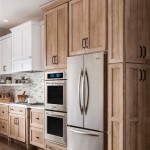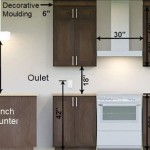What Is The Standard Size For Kitchen Cabinet Handles?
Determining the "standard" size for kitchen cabinet handles is not as straightforward as identifying a single, universally accepted measurement. Instead, it involves understanding the various factors influencing handle selection, the common sizes available, and the principles of design that contribute to a visually appealing and functional kitchen space. While a specific number eludes definition, a general understanding of these elements allows for informed decision-making during kitchen renovations or new construction.
Cabinet hardware, including handles and pulls, serves both an aesthetic and practical purpose. Functionally, they provide leverage for opening and closing cabinets and drawers. Aesthetically, they contribute significantly to the overall style and feel of the kitchen. The size and style of the handles must therefore complement the cabinets themselves, the overall kitchen design, and the user's ergonomic needs.
The absence of a rigid standard doesn't mean handle size is arbitrary. Instead, it allows for customization and adaptation to different kitchen layouts and design preferences. This article will explore the considerations that go into selecting the appropriate size for kitchen cabinet handles, offering a comprehensive guide to navigating the options available.
Understanding the Influencing Factors
Several factors influence the choice of handle size for kitchen cabinets. These factors relate to the size and style of the cabinets themselves, the overall aesthetic of the kitchen, and the user's personal preferences and ergonomic needs.
Cabinet Size and Proportion: The size of the cabinet or drawer is a primary determinant of handle size. Larger cabinets, particularly wide drawers, require larger handles to maintain visual balance and provide adequate leverage for opening. Conversely, smaller cabinets and drawers are better suited to smaller handles or knobs. A handle that is disproportionately large for a small cabinet will appear awkward and may even be difficult to use. Similarly, a handle that is too small for a large cabinet will look insignificant and may not provide sufficient grip.
The general rule of thumb is that handles should be approximately one-third the length of the drawer or cabinet they adorn. However, this is merely a guideline, and design considerations may dictate otherwise. For instance, on very wide drawers, two smaller handles might be preferable to one extremely long handle, both for aesthetic reasons and to distribute the force required to open the drawer more evenly.
Kitchen Style: The overall style of the kitchen plays a significant role in determining appropriate handle sizes and styles. Modern, minimalist kitchens often feature sleek, elongated handles that emphasize clean lines and a sense of understated elegance. These handles are typically made of stainless steel, brushed nickel, or other metals with a contemporary finish. Traditional kitchens, on the other hand, may incorporate more ornate handles with intricate detailing. These handles are often made of materials such as antique brass, oil-rubbed bronze, or porcelain.
Farmhouse kitchens tend to favor rustic handles, often made of wrought iron or wood. The size and style of the handles should harmonize with the other design elements in the kitchen, such as the cabinet door style, the backsplash, and the countertop material. A cohesive design scheme creates a visually appealing and harmonious space.
Ergonomics and User Preferences: Ergonomics, the science of designing equipment and workplaces to fit the user, is a crucial consideration in handle selection. The handles should be comfortable to grip and use, and they should be positioned in a way that minimizes strain on the hands and wrists. The user's hand size and grip strength are important factors to consider. Individuals with larger hands may prefer larger handles, while those with smaller hands may find smaller handles more comfortable. The handles should also be easy to grasp, even with wet or slippery hands.
Personal preference also plays a role. Some individuals prefer the feel of a solid, substantial handle, while others prefer a lighter, more delicate handle. The best way to determine the most comfortable and ergonomic handle size is to test different options in person. Many kitchen showrooms offer a variety of handles to try out, allowing users to experience the feel and functionality of each option before making a purchase.
Cabinet Door Style: The construction and style of the cabinet door itself can influence handle selection. For example, shaker-style cabinets, with their recessed panel design, often look best with relatively simple, understated handles. Raised-panel cabinets, on the other hand, can accommodate more ornate handles that complement the decorative detailing. The thickness of the cabinet door can also affect the choice of screws needed to attach the handles. Thicker doors require longer screws to ensure a secure and stable installation.
Consider the placement of the handle relative to the door style. On shaker doors, handles are often placed on the stile (the vertical frame member) of the door. On slab doors (flat, unadorned doors), handles can be placed anywhere on the door face, allowing for greater flexibility in design.
Common Handle Sizes and Measurements
While there's no single "standard," certain handle sizes are more commonly encountered and provide a good starting point for selection. Handle sizes are typically measured center-to-center (CTC), which is the distance between the screw holes. Understanding CTC measurements is crucial for accurate installation and replacement of handles.
Small Handles (1-inch to 3-inch CTC): These smaller handles are typically used on smaller drawers and cabinets. They are also suitable for use as knobs, which have a single mounting point instead of two. These smaller sizes are often found in bathrooms or on small accent cabinets within the kitchen.
Medium Handles (3-inch to 5-inch CTC): This is a very common size range for kitchen cabinet handles. These handles are versatile and can be used on a variety of cabinets and drawers. They offer a good balance between functionality and aesthetics, providing sufficient grip without being overly large or imposing.
Large Handles (5-inch to 8-inch CTC): Larger handles are typically used on larger drawers and cabinets, such as pantry doors or wide base cabinets. These handles provide ample leverage for opening heavy drawers and add a touch of visual drama to the kitchen design.
Extra-Large Handles (8-inch and above CTC): These oversized handles are often used in contemporary or modern kitchens to create a bold, statement look. They are typically used on very large drawers or as accent pieces on islands or other prominent features. These handles should be carefully chosen to ensure they are proportionate to the size of the cabinet and the overall kitchen design.
It’s important to note that the overall length of the handle will be greater than its CTC measurement. The overall length includes the end pieces of the handle that extend beyond the screw holes. When selecting handles, consider both the CTC measurement and the overall length to ensure they fit comfortably on the cabinet or drawer.
Practical Application and Design Considerations
Beyond understanding the factors and common sizes, the practical application of these principles through careful planning and design consideration is paramount.
Planning and Layout: Before selecting any handles, carefully plan the kitchen layout and determine the placement of cabinets and drawers. Consider the traffic flow in the kitchen and ensure that handles are positioned in a way that doesn't obstruct movement or create potential hazards. For example, avoid placing handles on lower cabinets in areas where they might be easily bumped into. Visualize how the handles will look on the cabinets and drawers, and consider the overall balance and symmetry of the design.
Consistency vs. Variety: Decide whether to use the same size and style of handles throughout the kitchen or to incorporate variety. Using the same handles throughout creates a cohesive and unified look, while using different handles can add visual interest and personality. If choosing to use different handles, ensure that they complement each other and maintain a consistent design theme. For example, using similar finishes or styles can create a sense of harmony even when using different sizes.
Testing and Mockups: Before making a final decision, test different handle sizes and styles on the actual cabinets and drawers. Use painter's tape to temporarily attach handles to the surfaces and step back to evaluate the overall look. This allows for visualizing how the handles will appear in the finished kitchen and ensures that they are proportionate to the cabinets and drawers. Mockups can also help to identify any potential ergonomic issues, such as handles that are too difficult to grip or positioned in a way that causes strain.
Finish and Material Selection: The finish and material of the handles are just as important as the size. Choose finishes and materials that complement the other design elements in the kitchen, such as the cabinet color, the countertop material, and the backsplash. Common finishes include stainless steel, brushed nickel, oil-rubbed bronze, antique brass, and matte black. Consider the durability of the finish and choose materials that are resistant to scratches, stains, and fingerprints.
Professional Consultation: If feeling overwhelmed or unsure about handle selection, consider consulting with a kitchen designer or interior designer. These professionals can provide expert guidance and help navigate the many options available. They can also assist with creating a cohesive and visually appealing kitchen design that meets both functional and aesthetic needs. A professional consultation can be a valuable investment that ensures a successful and satisfying kitchen renovation.
By considering cabinet size, kitchen style, ergonomics, and personal preferences, it becomes evident that a single "standard" size for kitchen cabinet handles is limiting. A more nuanced approach, incorporating these factors, will lead to a selection that is both functional and aesthetically pleasing, enhancing the overall kitchen design.

How To Choose Hardware Pull Size For Your Cabinets
How To Choose The Best Size Pulls For Your Cabinets Trubuild Construction
Cabinet Hardware Sizing Guide The Knobbery Door Bath Accessories Faucets Furniture Knobs And Pulls

The Right Length Cabinet Pulls For Doors And Drawers Porch Daydreamer

The Right Length Cabinet Pulls For Doors And Drawers Porch Daydreamer

Comprehensive Guide To Cabinet Hardware Size Placement Handles More

A Simplified Guide To Understanding Standard Handle Sizes House
Cabinet Hardware Sizing Guide The Knobbery Door Bath Accessories Faucets Furniture Knobs And Pulls

The Right Length Cabinet Pulls For Doors And Drawers Kitchen Hardware

How To Measure Kitchen Cabinet Handles The Handmade Handle Company
Related Posts








